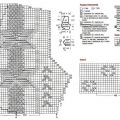
Simple patterns knitting knitting needles for beginners and experienced needlewomen, we knit products with simple patterns, stocking knit and pattern "holes" with patterns and free description.
Knitting with knitting needles: simple patterns Every person wants to look beautiful and, of course, feel confident. In this you can help unique clothes, which you will connect with the help of the spokes with your own hands. This article contains some of the most popular and interesting patterns with patterns for making beautiful clothes with knitting needles. Our simple patterns will be able to relate even beginner needlewomen. Lesson 1. Knitting pattern "holes". For this type of pattern is a characteristic rare arrangement of holes on the facial surface. Of course, the frequency of the holes can be any, the main thing - the principle of knitting. As a sample, type the number of spokes with a spokes, a multiple of twelve + two eyelets per symmetry + two edges. 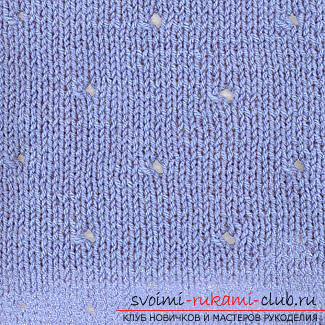 The first row. The combination is repeated: the cape, the two eyelets together face (behind the back wall, with each loop first turning), ten facial; then a cloak, two eyelets together facing. The second row and all even rows are knitted on the wrong side. The third, fifth, seventh and ninth rows are knitted with facial loops. In the eleventh row the following combination is repeated: six facial, a cape, two eyelets together facial behind the back wall, four facial; finish with two facial. In the thirteenth, fifteenth, seventeenth and nineteenth rows, all the cords are tied with facial. After that, the pattern is repeated from the first row. Knitting Pattern:
The first row. The combination is repeated: the cape, the two eyelets together face (behind the back wall, with each loop first turning), ten facial; then a cloak, two eyelets together facing. The second row and all even rows are knitted on the wrong side. The third, fifth, seventh and ninth rows are knitted with facial loops. In the eleventh row the following combination is repeated: six facial, a cape, two eyelets together facial behind the back wall, four facial; finish with two facial. In the thirteenth, fifteenth, seventeenth and nineteenth rows, all the cords are tied with facial. After that, the pattern is repeated from the first row. Knitting Pattern: 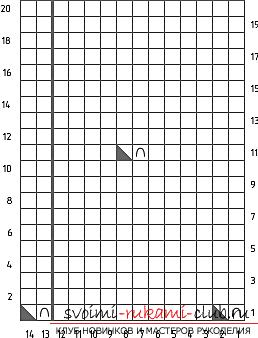 Lesson number 2. Learning to do hosiery. In stocking, there are several names: jersey and face. It can be argued that this pattern is most often used during knitting with knitting needles.
Lesson number 2. Learning to do hosiery. In stocking, there are several names: jersey and face. It can be argued that this pattern is most often used during knitting with knitting needles.  Its implementation is not difficult: The first row is tied with the eyelets. The second row is tied with the wrong loops. After this, the pattern is repeated from the first row. Just perform knitting and farther: odd front rows knit with facial, and even purl - with purl loops. During knitting in the circular, each eyelet is crocheted. Knitting this pattern can be done face and purl in one of two ways, but in any case do not mix them.
Its implementation is not difficult: The first row is tied with the eyelets. The second row is tied with the wrong loops. After this, the pattern is repeated from the first row. Just perform knitting and farther: odd front rows knit with facial, and even purl - with purl loops. During knitting in the circular, each eyelet is crocheted. Knitting this pattern can be done face and purl in one of two ways, but in any case do not mix them.  The advantage of the jersey, which distinguishesit from the relief pattern, is the ability to subject it to a wet-heat treatment (using an iron or steam), taking into account the fibrous composition of the yarn and the recommendations for care. Lesson number 3. Knitting a tight fine pattern. This pattern is very formostoychiv, because the width and length is stretched poorly. As a sample, we dial the number of spokes by a needle, a multiple of 4 + 2 edges. In the first row, this combination is repeated: one purl, three facial.
The advantage of the jersey, which distinguishesit from the relief pattern, is the ability to subject it to a wet-heat treatment (using an iron or steam), taking into account the fibrous composition of the yarn and the recommendations for care. Lesson number 3. Knitting a tight fine pattern. This pattern is very formostoychiv, because the width and length is stretched poorly. As a sample, we dial the number of spokes by a needle, a multiple of 4 + 2 edges. In the first row, this combination is repeated: one purl, three facial. 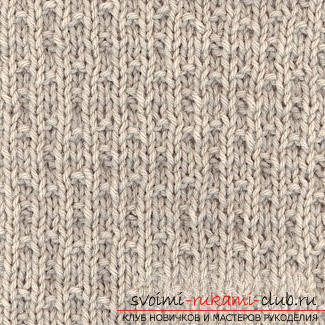 Second row. Repeat the sequence: one purl, front and two purl. In the third row all the eyelets will be facial. The fourth row: repeating three purlins, one facial. In the fifth row, we repeat the following sequence: one purl, three facial. In the sixth row, each loop will be purl. The seventh row. We repeat this combination: two facial, purl, facial. In the eighth row we repeat: three purlins, one face. In the ninth row, each eyelet will be facial.
Second row. Repeat the sequence: one purl, front and two purl. In the third row all the eyelets will be facial. The fourth row: repeating three purlins, one facial. In the fifth row, we repeat the following sequence: one purl, three facial. In the sixth row, each loop will be purl. The seventh row. We repeat this combination: two facial, purl, facial. In the eighth row we repeat: three purlins, one face. In the ninth row, each eyelet will be facial. 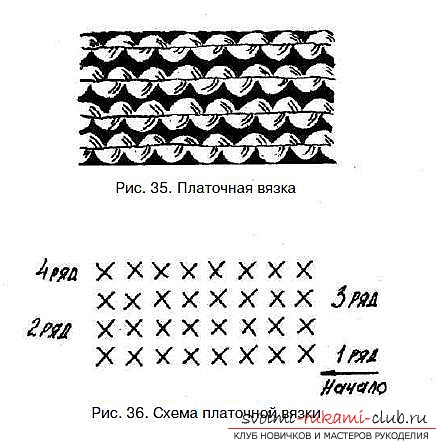 Tenth row. We do a repetition of such a sequence: one purl, one obverse, two purlins. Eleventh row. This combination is repeated: two facial, one purl, one facial. In the twelfth row, all the loops are knitted with the wrong side. After this, the pattern repeats, beginning with the first row. Knitting Pattern:
Tenth row. We do a repetition of such a sequence: one purl, one obverse, two purlins. Eleventh row. This combination is repeated: two facial, one purl, one facial. In the twelfth row, all the loops are knitted with the wrong side. After this, the pattern repeats, beginning with the first row. Knitting Pattern: 



